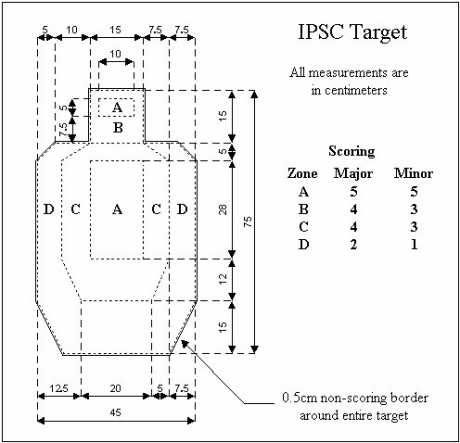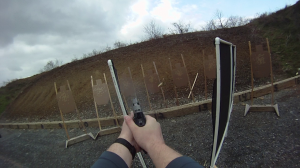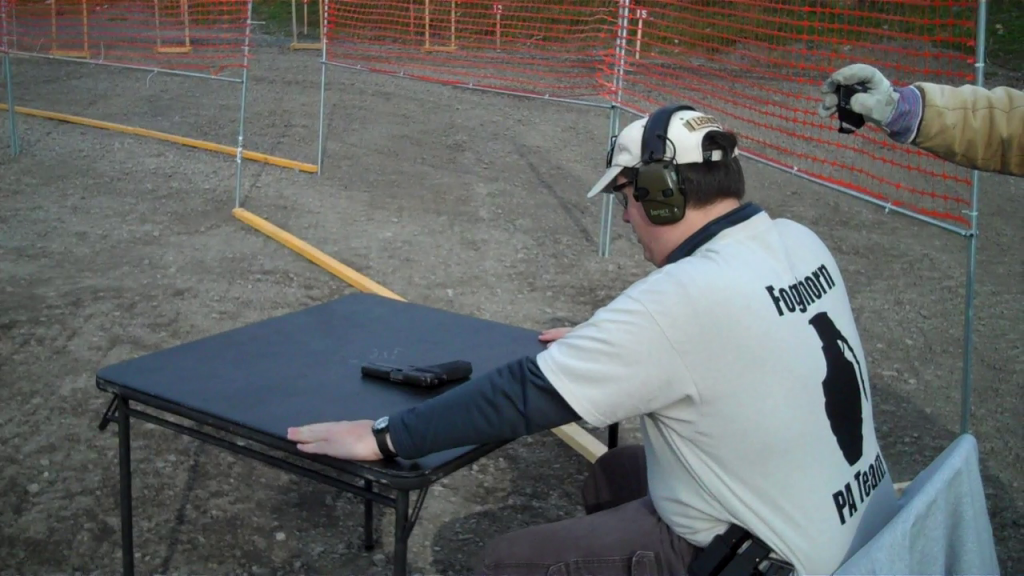All right class, settle down. It’s time to start the next lesson. First we looked at 3-gun competitions, king of the shooting sports. Then we looked at CMP / NRA High Power, the classiest of the shooting sports. In this tutorial we examine USPSA, the original “run and gun” shooting sport.
Before we go any farther, I want to share some sage advice I got from one of the old timers at Quantico. When I asked him some USPSA related questions, he handed me a stack of papers with the following list on the top. These apply to just about everything, but especially here.
- All NRA safety rules apply, no matter how fast you think you are going.
- It’s just a pistol match.
- Guns don’t go off by themselves, no matter what the Washington Post says.
- It’s just a pistol match.
- Shooting is fun, don’t forget it.
- It’s just a pistol match.
- You can’t recall a bullet.
- Some guns don’t work very well, no matter what the shooting press says.
- It’s just a pistol match.
- All guns fail at some time, be ready.
- It’s just a pistol match.
What is USPSA?
USPSA stands for United States Practical Shooting Association, an organization which is the American arm of the International Practical Shooting Confederation. IPSC matches are all about shooting pistols, moving through courses, and doing it fast (although USPSA does have a set of rules for 3-gun as well). IPSC/USPSA was the predecessor to the modern 3-gun competition, so a lot of things overlap between the two sports. There are quite a lot of rules, but we should just about cover everything if you read carefully.
But what is it all about? Well, let’s throw a couple videos your way. First a really hot chick getting dirty.
http://www.youtube.com/watch?v=fG3w9TKBvAA
And now yours truly about a half a year ago at my first USPSA match.
http://www.youtube.com/watch?v=wCs8hvEo1GU
Guns. Targets. Split second shoot / no shoot decisions. MOVING targets. Steel. And all for the price of admission and some cheap pistol ammo. The “practical shooting” name originally came from the real-life scenarios that were constructed for the shooters to run. Modern USPSA matches have become more of a game than practical shooting practice.
I was talking to Jeff Hoge (old dude who’s been involved since the stone age) a few weeks back about the history of USPSA. He detailed the schism in the mid 1990s, when “race guns” (pistols designed specifically for USPSA, typically with compensators and red dot sights) were becoming popular. He said that there was a part of the membership (led by Mr. Wilson of Wilson Combat) that wanted to stay true to the “practical” shooting roots. They eventually broke off and founded IDPA shooting competitions, which we’ll discuss later. Since then USPSA has become more “game” like and less about the practical side.
Click here for the rulebook
What kind of equipment do you need?
All you really need is a pistol, a holster, and some ammo. If you’re running a semi-auto you’ll probably need magazines for that too. The divisions (SURPRISE SURPRISE there are divisions! Extra credit if you saw that one coming!) are broken up by the equipment you use, so you’ll never be directly competing against someone with a Karl Lippard 1911 and a red dot. There typically is a minimum caliber of 9x19mm Parabellum, but some matches run entire divisions of .22lr pistols.
The basic divisions are:
- Revolver – Just what it sounds like, revolvers only. Speedloaders are welcome, but loading one at a time works too.
- Production – This is the division in which you want to start if you have a “modern” pistol. Production division was designed with police officers in mind so they can use their duty equipment to get some practice. Only production models are allowed, no custom pistols here. There is a list with the “official” production guns, but as long as it’s a mass produced pistol you’re fine. Holster must completely cover the trigger and be “duty style,” and you’re limited to 10 rounds per magazine to make it fair for everyone (10+1 in the chamber is cool to start, though). All pistols are scored as “minor” to further level the playing field, more about that later.
- Single Stack – The 1911 only club. Seriously, 1911s only here. Not even a Browning Hi-Power makes the cut. Pistols must be of the standard design (no fancy ported barrels or red dots) and holsters must be “duty style” as well. 8 rounds per magazine max. A good division to start if you have a 1911.
- Limited – Now we’re getting into “race gun” territory. This division technically has most of the same rules as Production, with two major changes. First difference is that there is no limit on the capacity of the magazines, so load those suckers up. The second difference is that “race” holsters can be used. These are specially designed holsters to allow for lightning fast draw speed, and barely hold onto the gun. Not something you’d want to open carry down Main Street with, but it works just fine for USPSA.
- Open – Just about anything goes, as long as it’s safe. Want a red dot sight? Go for it! Gigantic muzzle brake? Slap it on there! Double stacked 45 ACP? Sure, why not! I’m sure if you could figure out how to get a gyroscopically stabilized computer aiming system to fit in a holster it would be legal. The only real restriction is that the magazine cannot exceed 171.25mm in length.
How does scoring work?

Scoring is identical to the 3-gun scoring system, with the exception that “power factor” is in use. What is power factor? Glad you asked.
Take the weight of your bullet, in grains. Multiply that by the muzzle velocity of your ammunition, in feet per second. Now divide that number by 1,000. That, my friends, is your “power factor.” Power factor was designed to level the playing field in terms of recoil. Larger recoil rounds means slower follow up shots, and in order to balance that out USPSA gives larger rounds a little leniancy. A hit that’s worth 3 points for a small bullet is worth 4 points for a large one, and so on. Keeps things fair.
The minimum power factor for “minor” scoring is typically 125, and the minimum power factor for “major” scoring is 165. Some matches allow smaller calibers, check with your local match director.
The trick to getting a good score is going really, really fast. Most matches use comstock scoring only, meaning whatever score you get is divided by your time. The sooner you’re done, the more points you have. Don’t try to get a perfect sight picture every time, just get a “good enough” picture, take the shot, and move on. That’s the difference between the two videos above, I was getting that “perfect” picture and the smokin’ hot babe was basically point shooting. As long as you hit the target somewhere you’re good, just move on. Giving up that “perfect” picture has moved me into the top 10 among the shooters here, including some of the FNH USA team.
How do matches / stages typically work?
Listen very closely to this first part. When you get to a match, DO NOT holster up at the car. Leave your gun in your bag, but strap everything else on. When you’re ready to put your pistol on, head over to a “safe area.” These will be clearly marked and have other people standing around fingering their pistols. In a safe area you may handle your pistol to put it on or take it off, and is the only place on the range you can do so unless an RO is standing over your shoulder and telling you to do it. Failure to pay attention to this rule can earn you a match disqualification, so pay attention. DO NOT handle any ammo in the safe area, this will also get you in trouble.
Other than that small difference, USPSA matches basically run the same way a 3-gun match runs. Go re-read my 3-gun post if you haven’t already done so. The two things that are probably going to trip you up in this sport are the start positions and the stage design.
The “start position” is how you start the stage. For the vast majority of the stages you run it’s going to be “pistol loaded to division capacity, holstered, hands at sides” or some variation on that. Hands are often placed on specific marks, like the steering wheel of a car or two blue marks on a piece of PVC pipe. Where you’re going to get tripped up is something like the above picture, where the start position was “pistol with loaded magazine, empty chamber, safety engaged, seated with hands on table.”
This means at the buzzer you need to get up, disable any safeties, rack the slide, and then start firing. A lot to remember, and certain to trip up a new shooter. Start position can be whatever the match director wants, so be ready for anything.
The other thing that can trip up new shooters is the stage design. Some designers intentionally have shooters moving right to left with a loaded handgun. Now, stop and think about this. If you’ve got a gun in your right hand, and you want to run to the left, where is the muzzle going to be if you do a reload? Pointed right towards the crowd, of course.
Designers think this is a great idea, and try to disqualify people that way, but personally I think it’s dangerous and dumb. Oh well, nothing I can do about it. It happens all the time. Just remember to always keep the muzzle of your gun pointed downrange and you’ll be fine.
The best advice I can give new shooters was said in the quoted list at the beginning of the article. It’s just a pistol match. You’re out to have fun, so relax. When shooters get tense they rush things and bad things start to happen, like negligent discharges and hands being blown off. Take a breath, you’ll do fine. Relax. Have fun.
How do I find matches near me?
Thankfully USPSA has a match listing function on its website. If that doesn’t help, Brian Enos’ forum is always a good place to look.
Is it worth it?
If you already own the pistol and the magazines, there’s no reason not to do it. The training you get, while not necessarily directly applicable to defensive shooting, will at least give you an idea of how you perform under pressure. Plus, it’s just so damn fun!
Next time: IDPA!







Great write up! IDPA and IPSC are the most fun you can have a gun that’s legal! Great training on gun handling, shooting and working under stress–highly recommended!.
Just keep in mind, that if you have a gun for defense, the techniques that help you win in the sports can get you killed on the street. Temper your sport training with defensive skill training!
I received my membership cards for the USPSA and SCSA last week, and I think it’s going to be a lot of fun.
If you compete, then they will have to determine the scoring for a power factor of infinity.
If you can’t handle ammunition in the safe area, where do you load your magazines?
You can handle your gun ONLY at the safe areas and on the range when directed by the range officer.
You can handle ammo and load mags anywhere EXCEPT the safe areas.
Great writeup, but I think readers may get the wrong impression from the statements “Some designers intentionally have shooters moving right to left with a loaded handgun” and “Designers think this is a great idea, and try to disqualify people that way.” Course designers cannot dictate which direction the shooter moves. A right-handed shooter would chose to safely run such a course right to left, while a left-hand shooter would choose to run the opposite direction. I know of no course designers that “try” to disqualify shooters. Think about it, if you say they are doing this intentionally, it follows that they are intentionally putting spectators in harms way. The folks that participate in shooting sports are the most safety conscious people I know.
Otherwise an excellent article, and one that I will share with friends to help explain how I’m spending my weekend.
Cheers!
David,
I’m glad you liked the article!
I agree, USPSA shooters are the most safety conscious people I know. That comment stems from a conversation I had with the match director after I ran a stage that required the shooter to run right to left on a stage (start box on the right, “stop” plate on the left behind hard cover), and he stated that it was intended to make people focus more on muzzle control than the targets and subsequently forget about a target that was only visible from the middle of the course. My interpretation was that he was being a douchebag, trying to DQ shooters. Naturally the RO would stop someone (or at least try) before they break 180, but still it’s a dangerous design.
I’m planning a whole series of posts detailing some of the best and worst stages I’ve ever run, what they did right, and what they did wrong. I’d love to hear about your favorite stages if you have some time to email me. Nick dot leghorn at gmail.
“you’ll never be directly competing against someone with a Karl Lippard 1911 and a red dot. “
They have a 400 yd. range?
hahaha! nice…
Mr. Leghorn,
Nice article, but I really don’t understand your comment of “Some designers intentionally have shooters moving right to left with a loaded handgun… where the muzzle [is] pointed right towards the crowd….try to disqualify people that way.”
No one wants to get shot, including the stage designers and RO’s, so no USPSA shoot that I have ever been in would want to “trick” you into sweeping the crowd with a handgun, loaded or not. And you can move any way you want; right, left, up (with wings), down (with a shovel), and it is completely your choice.
And I have yet to hear about even a single hand, much less multiple “hands being blown off”, at any USPSA competition. Have you?
-Bill
PS: A great site with a lot of good info!!
Hello, thanks for the info! So if I have a trijicon red dot sight on my gun would i be able to compete in all the pistol events. thanks
Only in OPEN events…
Good writeup… headed out the door to my first USPSA match in 30 mins…
I know this is an old article, but there’s info in here that is not true. Limited has 140mm limit on mag length and open has 170mm max length. Also, you can move holster and pouches anywhere on belt in limited. Theres a lot of rule changes between production and limited, contrary to this article. Also there are a lot of mass produced guns that are not production legal. I know you linked up the list, but you said most are legal. There’s a box for size requirements too. Scoring is nothing like 3 gun either. Other errors, but just do your own homework people
“A” hit is very important for people who wants to reach the top of this sport. With top shooters, all “A” hits and smooth movement are the must. At local club level, that may not hold true.
When good shooters get almost all “A” with smooth efficient movements, others have no way to win with something so call “speed run”.
“Speed” will come when ready. “A” hits, may never with some shooters.
can you have a trigger job/zev trigger in production/limited class? Fiber optic sights? newby here
Comments are closed.